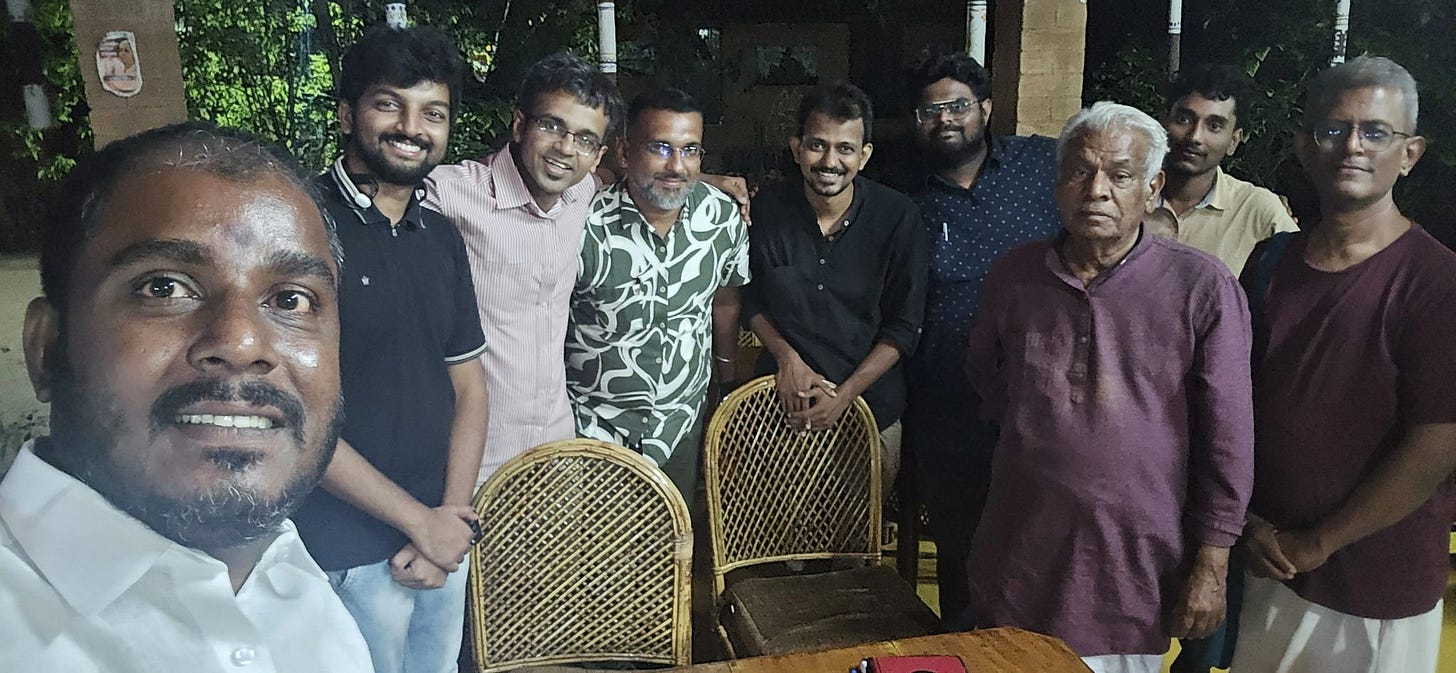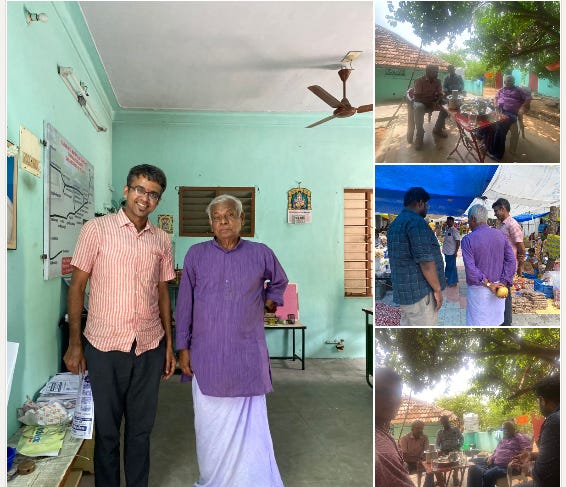Sunday Reflections (Protected Cultivation, Physics of Agritech Startups, Future of Land Reforms)

Dear Friends,
Greetings from Hyderabad, India. My name is Venky. Welcome to Sunday Reflections where I reflect on what I’ve written and ask myself, In doing what I am doing, what am I really doing?
Subscriber-only Plugins
Dhanuka Agritech’s International Ambitions
Dhanuka’s 165-crore deal with Bayer AG for the rights to the latter’s fungicides, Iprovalicarb and Triadimenol, signals its burgeoning international ambitions. In the words of the Dhanuka Chairman, the agreement targets markets in “over 20 countries across LATAM, EMEA, and Asia, including India, marking the firm’s entry into the global agrochemical market.”.
Both of these products are valued at more than 250 crores INR and they found a very good opportunity in marketing these products, hitherto ignored due to internal portfolio clashes within Bayer.
“Iprovalicarb is the bigger revenue driver, contributing roughly 55% of revenue, while Triadimenol contributes about 45%. Although Triadimenol is a larger product with around 25% market share under its existing brand, the rights to its brand name were not acquired because they were tied to Bayer’s legacy branding (including the use of "B-A-Y") and couldn’t be transferred.
With these acquisitions, Dhanuka is building a business model for markets outside India that involves owning a basket of products and brands, with registrations in their name. Distribution would be managed through a national distributor with flexible manufacturing options. Dhanuka also plans to expand its product portfolio further, either organically or through future acquisitions. (Source: Dhanuka Q3 FY25 Analyst Call)
This further led me to investigate their portfolio, which includes six biologicals, three herbicides, and two insecticides.
Dhanuka still counts “Biologicals” under “Others” with Insecticides contributing 29.99%; fungicides contributing 19.96%; herbicides contributing 34.71% and others 15.34% in product category-wise percentage share of turnover for Q3 FY 25.
More in a recent subscriber-only edition of Agribusiness Matters.
Is there a Future for Protected Cultivation in India
Few days ago, The Plate India came up with a great story on Rajasthan’s millionaires who’ve made their money from protected cultivation.
“An acre of polyhouse farming yields, on average, 100 tons of cucumbers annually, significantly higher than the 20-30 tons per acre typical of traditional open-field cucumber farming. Prices can soar to ₹35 per kilogram when demand spikes, but most farmers prefer fixed-price, long-term contracts with buyers. The current going rate is around ₹25 per kilogram, translating to a revenue of ₹25 lakh per acre.
Polyhouse farmers typically employ resident worker families, known as seeri, who receive 25% of the total income. After accounting for their wages and roughly ₹5 lakh in input costs, farmers can net a profit of ₹12 to 15 lakh per year from an acre.
Though yellow and red bell peppers yield only 35 tons per acre, far less than cucumbers, their income potential is higher since prices can climb to ₹250 per kilogram.”
Companies like Eeki have built their businesses by building technologies for protected cultivation besides investment models with polyhouse contractors, polyhouse growers and farm partners.
As an agritech analyst, I go by first principles. Any business model that violates the Chinese firewall guidelines and combines investment and implementation simultaneously carries the risk of losing objectivity with biased decision-making.
Currently, protected cultivation relies on governments subsidizing the capital costs and they are terrible when it comes to energy efficiency. The 2024 CEA Census makes it clear that growers across the protected cultivation world demand energy efficiency as the major ask from technology providers.
More in a recent subscriber-only edition of Agribusiness Matters.
Physics of Agritech Startups
When I read Rob Snyder’s brief meditation on the physics of startups, I wanted to, with due apologies to Walt Whitman, sound my barbaric agritech yawp over the rooftops of the world.
Here’s the thing. We’re taught about the physics of agritech startups backwards:
The typical agritech story goes thus:
-> Founder wants to feed the world by 2050 with bleeding-edge technology.
-> Builds an awesome product/software in the lab/sandbox.
-> Convinces farmer/trader they should want it in the field.
-> Hires a bunch of Village-Level Entrepreneurs(VLEs) to "scale" -> Floats a non-profit foundation to “hyperscale”.
What is really happening underneath is this:
-> Founder finds untapped demand: Buyers trying to accomplish something in their lives with terrible options such that there is "space" for a product.
When farmer customers are frustrated with low-quality mulching sheets/kitchen-brew agri-input biologicals laced with synthetic pesticides, when premium 1 % urban consumers are unable to find authentic farmer-sourced commodities, when farmers are frustrated with terrible logistics services, when farmers are treated with half-assed products with infantile messaging, enterprising founders find a “space” for a product.
-> Founder builds a product that "fits" this shape of space - and as a result, buyers PULL the product out of the startup (they BUY more than the startup SELLS) -- and we perceive it as a good product
Founders builds a product that “fits” the demand curve economics of the traders and cost-conscious consumers and the first-mile - and as a result, buyers PULL the product out of the startup.
Pay close attention to two important nuances hiding here in plain sight.
One: Both the place and customers influence the demand-curve economics.
Two: The shaping constraints work well in the case of traders and consumers, but not farmers. Because, let’s face it. If Farmers were to farm on the basis of supply and demand, today, no farmer would be doing farming in the first place. (I touched on this point few moons ago: Maslow’s Hierarchy Be Damned)
I love Sarah Taber’s takes on US Farming and she nails this point in the US Context: Small and medium land-holding farmers don’t do corn and soy because of subsidies. Crop subsidies do impact farm economics, but monoculture’s persistence stems more from deep-rooted cultural habits, practical constraints, and structural time-management decisions. They are not driven by top-down economic incentives. Here is where things get interesting: Outwardly, both the typical and the real story appear like they're the same:
-> Agritech Startup grows fast
-> Agritech Startup builds cool product
-> Agritech Startup hires VLEs to scale
But we are taught the causality backwards. When a VC says that you should hire channel sales if you're not growing fast, its important to get the causality straight.
Hiring channel sales (typically with a strong agri-input background) is something that fast-growing agritech startups do. They don't do this to grow fast. They do it because they've found demand.
Pepsico’s Lays Advertises Their Soil Testing Centers
Lays comes up with a mushy ad - where Mother Earth pens an emotional letter to a grower - that highlights their Mitti Jaanch Kendras (Soil Testing Centers). Mother Earth pens an emotional note to PepsiCo after reading Pepsico's Sustainability Goals.
Dear PepsiCo,
I’ve been watching you and your antics closely, as I do with all my children. You’ve revised your sustainability goals when glaciers are collapsing. You speak carefully—almost apologetically—about them. I understand. These are strange and difficult times for those talking about sustainability while playing corporate survival games.
You want to expand regenerative agriculture from 7 M to 10M acres. But if you are aware that soil needs healing, why is your definition of regenerative wishy-washy?
Why are you now aiming for 90% responsible sourcing instead of 100%?
Some of your shifts make me uneasy. Plastic—still so much of it. Cutting recycled content from 50% to 40%, and turning your reuse targets into silence? You were starting to lead there. Why step back now, when the oceans and landfills are already full?
And some decisions—like dropping goals for community recycling—feel like you’re looking away just when people need encouragement the most. Language matters. “Aspiration” is not a plan.
I’m still here, watching, nourishing, sustaining. I can regenerate myself with you or without you. I am only concerned about you and your stakeholders' children.
With hope,
Mother Earth
Madurai Agripreneurs Meet
Madurai Agripreneurs Meet happened at Gandhian Institute CESCI few days ago with great pomp and fun.
The Center for Experiencing Socio-cultural interaction campus was beautiful with its rich Gandhian heritage history and made the evening special. Sabarinivas Elangovan joined us from Pattukottai. He shared deep questions on the business model of making sustainable transitions in the rice ecosystem. Entrepreneurship is a deep test of character and mettle and it was fascinating to hear his story of inspiration which begins from Nammazhvar Ayya.
Aslam Kouther joined us from Podinaikkanur. Aslam shared the challenges involved in growing cardamom, being six generation planter and the challenges involved in transitioning practices across generation.
Madurai social entrepreneur friend Krishnan N S also joined us. I visited his factory and learned so many aspects of his inspiring journey. He penned an inspiring note of reflections after this meetup here.
Ramakrishnan and Adinaveen, an aspiring entrepreneur joined us from Madurai. Ramakrishnan is the son of a commission agent and is eager to create impact by working more closely with farmers.
Bhoodan Movement and Future of Land Reforms
How to understand the longstanding impact and legacy of Vinobha Bhave's Bhoodan movement? How do we understand the fascinating legacy of the land reforms that happened in this country during the fifties and sixties? What is the future of land reforms today when Nandan Nilekani moots land tokenization as a solution to unlock the true value of land?
This and many more questions were running in my mind when I ventured out to Madurai to meet ASSEFA Loganathan Annachi and Ulaganathan Annachi.
Thanks to the incredible generosity of Ramasubramanian Oruganti who has been dialoguing with me for several weeks and sharing his priceless wisdom of being a grass roots activist for four decades, I had been hearing amazing things about the work done by these stalwarts and my intent was to see if I could convince both of these stalwarts to do a podcast with me.
You see, in a country like India, there are phenomenal unsung warriors whose work remains hidden from public purview despite the ground breaking impact they've created in rural India.
How many of us know the incredible story of Vinobha Bhave who walked on foot through India, asking landowners for the gift of a plot of land to be allocated to the poorest peasants? How many of us know that he collected the land equivalent to Scotland for free distribution among landless? He collected 4,193,579 acres of land for redistribution. Today, it sounds like a work of miracles - It feels almost impossible to imagine.
ASSEFA was co-founded in 1969 by Sri Loganathan and an Italian, Giovanni Ermiglia in Tamil Nadu to enable formerly landless families who had received land through a voluntary Gandhian land reform (the Bhoodan Movement) but who had no tools or animals to start farming.
I was incredibly lucky to spend half a day with Ulaganathan Annachi and a day with Loganathan listening to their varied stories. Loganathan annachi shared the current status of Bhoodan movement and the structures he has built to ensure the land remains always with the rural communities. He shared how he had to sell Guides and engineering books besides Gandhian books to ensure that the oldest bookshop in Madurai - Sarvodaya ilakkiya Pannai - remains vibrant since its inception in 1969.
India is a land of mysteries. When we venture out to rural India, we learn things that our rational, urban minds can barely comprehend. For me, these trips are sacred pilgrimages.
I compost my fears, anxieties (is there a career path involved in what I do? Is there a sustainable path to wealth creation in this path?) and concerns (does Indian agriculture have a vibrant future? What would farmers from 2047 tell the story of what we've done for their livelihoods?) in these pilgrimages. I don’t have clear answers to many questions. Whenever I come back from these pilgrimages, I feel charged up. I feel incredibly convinced of the magical power of following your dharma. When your heart and soul remains anchored in dharma, the path shows itself.
So, what do you think?
How happy are you with today’s edition? I would love to get your candid feedback. Your feedback will be anonymous. Two questions. 1 Minute. Thanks.🙏
💗 If you like “Agribusiness Matters”, please click on Like at the bottom and share it with your friend.




